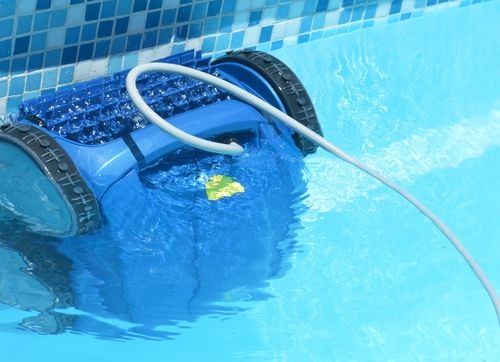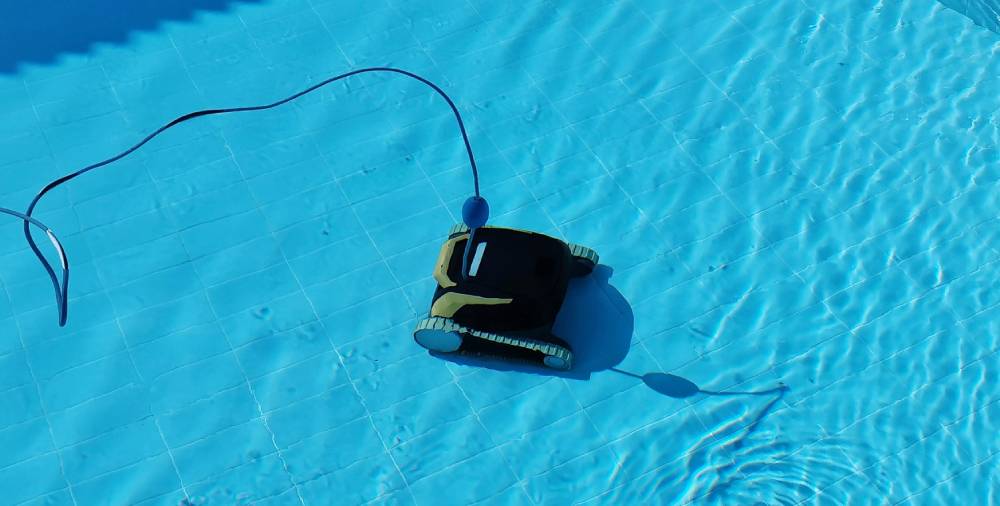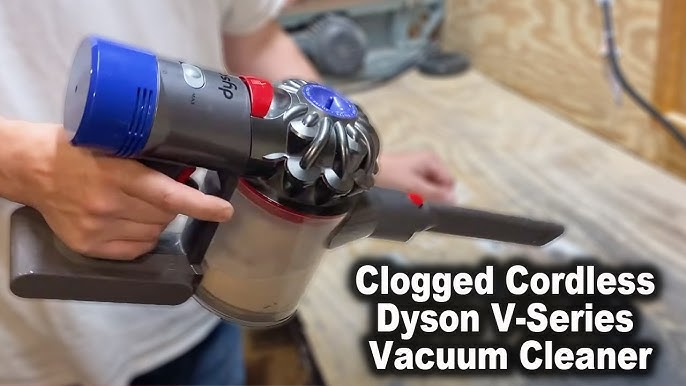How Does a Robot Pool Vacuum Work

A robot pool vacuum autonomously cleans your pool using built-in sensors and programmed algorithms. It removes debris and scrubs surfaces efficiently.
Robot pool vacuums have revolutionized pool maintenance. These devices operate independently, minimizing the need for manual cleaning. Equipped with advanced technology, they navigate the pool’s surface and walls, ensuring comprehensive cleaning. Their sensors detect obstacles, while algorithms optimize cleaning paths.
As a result, pool owners save time and effort, enjoying a consistently clean swimming environment. Modern models also offer features like remote control and scheduled cleaning, enhancing convenience. Investing in a robot pool vacuum not only improves pool hygiene but also prolongs the lifespan of pool equipment by preventing debris buildup.
Introduction To Robot Pool Vacuums
Robot pool vacuums are transforming pool maintenance. They clean pools efficiently without human intervention. These smart devices offer convenience and precision. Understanding their operation is fascinating and beneficial.
The Rise Of Automated Pool Cleaning
In recent years, automated pool cleaning has gained popularity. Robot pool vacuums are now common in many households. They save time and effort by handling the cleaning process. These robots use advanced technology to navigate and clean pools.
The demand for automated solutions is growing. People prefer smart devices for home maintenance. Robot pool vacuums are easy to use and highly effective. They represent a significant advancement in pool care.
Benefits Of Using Robot Pool Vacuums
Using a robot pool vacuum offers many benefits:
- Time-Saving: Robots clean the pool while you relax.
- Energy Efficient: They use less energy compared to traditional methods.
- Thorough Cleaning: Robots reach all pool areas, ensuring no spot is missed.
There are also health benefits. Clean pools reduce the risk of infections. Robot vacuums maintain water hygiene effectively.
Cost-effectiveness is another advantage. While initial costs are high, long-term savings are significant. Reduced energy bills and fewer chemicals needed for maintenance make them a wise investment.
| Feature | Benefit |
|---|---|
| Automated Cleaning | Reduces manual labor |
| Energy Efficiency | Lower electricity consumption |
| Precision | Thorough cleaning of all areas |
The Mechanics Of Movement
Understanding how a robot pool vacuum moves is fascinating. These devices aren’t just simple machines. They use advanced technology to clean your pool effectively. Let’s dive into the details.
Understanding Propulsion Systems
Robot pool vacuums rely on sophisticated propulsion systems to move. These systems are usually powered by electric motors. The motors drive wheels or tracks to propel the robot.
Here are the key components:
- Electric Motors – Provide the necessary power.
- Wheels or Tracks – Ensure smooth movement across surfaces.
- Propeller – Helps in moving water for suction.
| Component | Function |
|---|---|
| Electric Motors | Powers the wheels or tracks. |
| Wheels or Tracks | Enables the robot to move. |
| Propeller | Assists in water movement. |
Navigating The Depths: Sensors And Ai
Robot pool vacuums use sensors and AI for navigation. These technologies help the robot detect obstacles and map the pool.
Key technologies include:
- Sonar Sensors – Detects walls and steps.
- Gyroscopic Sensors – Helps in maintaining balance.
- AI Algorithms – Optimizes cleaning paths.
The sensors continuously gather data. The AI processes this data to adjust the robot’s path. This ensures efficient and thorough cleaning.
Powering The Clean: Energy Sources
How does a robot pool vacuum get its power? Energy sources are crucial for its operation. These machines need reliable power to function effectively. Understanding the energy sources helps you choose the right vacuum. Let’s explore the energy sources for robot pool vacuums.
Battery Technology In Robotic Vacuums
Modern robot pool vacuums use advanced battery technology. These batteries are usually lithium-ion. Lithium-ion batteries are lightweight and long-lasting. They provide consistent power for cleaning. Battery capacity varies among models. Higher capacity means longer cleaning time. Some vacuums feature replaceable batteries. This allows for extended use without waiting for a recharge.
| Battery Type | Advantages |
|---|---|
| Lithium-Ion | Lightweight, Long-lasting, Consistent power |
| Nickel-Metal Hydride | Environmentally friendly, High energy density |
Charging And Power Management
Charging and power management are essential for robot pool vacuums. These devices come with charging stations. You simply place the vacuum on the station to recharge. Some models have smart charging. This means they return to the station automatically when the battery is low.
Power management systems help optimize battery life. They ensure the vacuum uses energy efficiently. Some vacuums feature power-saving modes. These modes reduce energy consumption during less demanding tasks. Efficient power management extends the lifespan of the vacuum and its battery.
- Charging stations for easy recharge
- Smart charging for automatic return
- Power-saving modes for efficient use
Understanding the energy sources and management of robot pool vacuums helps you make an informed choice. Choose a vacuum with reliable battery technology and efficient power management for the best results.

Credit: www.youtube.com
Debris Collection And Filtration
Robot pool vacuums make pool cleaning easy. They efficiently collect debris and filter water. This section explores how these machines handle debris collection and filtration.
Types Of Filtration Systems
Robot pool vacuums use different filtration systems. These ensure clean pool water. Here are the main types:
- Cartridge Filters: These are easy to clean. They trap fine particles.
- Bag Filters: These hold larger debris. They are reusable.
- Canister Filters: These are durable. They handle both fine and large debris.
Capacity And Maintenance
Capacity is crucial for efficient cleaning. Larger filters hold more debris. They need less frequent emptying. Smaller filters need more frequent maintenance. Choose the right size for your pool.
Regular maintenance ensures optimal performance. Follow these steps:
- Check the filter after each cleaning session.
- Rinse the filter with a hose.
- Inspect for any damage.
- Replace filters as needed.
Proper maintenance extends the life of your robot pool vacuum. It ensures your pool stays clean all season.
Smart Features For Enhanced Cleaning
Robot pool vacuums use advanced smart features for thorough pool cleaning. These features ensure your pool stays clean without much effort from you.
Remote Control And Programmable Settings
Many robot pool vacuums come with remote control options. This allows you to direct the vacuum to specific areas. You can sit back and relax while the vacuum does its job.
These vacuums also offer programmable settings. You can set cleaning schedules for daily, weekly, or monthly cleaning. This ensures your pool is always clean when you need it.
| Feature | Benefit |
|---|---|
| Remote Control | Direct vacuum to specific areas |
| Programmable Settings | Set cleaning schedules |
Integration With Smart Home Systems
Some robot pool vacuums integrate with smart home systems. You can control them using voice commands through devices like Amazon Alexa or Google Home.
This integration makes pool cleaning even easier. You can start or stop the vacuum without even touching it. Your smart home system can notify you when the pool cleaning is complete.
- Control via voice commands
- Receive notifications on cleaning status
Durability And Longevity
Understanding the durability and longevity of a robot pool vacuum is crucial. These factors determine how long the device will last and perform efficiently.
Materials And Build Quality
The materials and build quality of a robot pool vacuum play a key role. These machines are made from strong and water-resistant materials. Common materials include high-grade plastic and stainless steel. These materials ensure the vacuum can endure harsh pool conditions.
High-grade plastic is lightweight yet strong. It resists chlorine and other pool chemicals. Stainless steel parts add to the strength and durability. They prevent rust and corrosion, ensuring long-lasting use. The combination of these materials ensures the vacuum remains reliable over time.
Wear And Tear: What To Expect
Even the best-built robot pool vacuums face wear and tear. The constant movement and cleaning can cause parts to wear out. Here’s a simple breakdown:
- Brushes: These scrub the pool surface and may wear out first.
- Filters: They trap dirt and debris, needing regular cleaning or replacement.
- Wheels or Tracks: These parts move the vacuum and may show signs of wear.
Regular maintenance can extend the life of these parts. Clean the filters and check the brushes often. Replace worn-out components to keep the vacuum working well.
Safety And Compliance Standards
Robot pool vacuums are convenient but must meet safety and compliance standards. These standards ensure the device works safely in wet environments. Two main areas of focus are waterproofing and electrical safety, and certifications and consumer assurance.
Waterproofing And Electrical Safety
Waterproofing is crucial for robot pool vacuums. The vacuum operates in water, so it must be sealed. Sealing prevents water from entering the electrical parts. This ensures the device runs safely and smoothly.
Electrical safety is also vital. The vacuum needs special wiring to prevent electric shocks. Using high-quality insulation materials helps achieve this. Manufacturers follow strict guidelines to ensure the device is safe to use in a wet environment.
Certifications And Consumer Assurance
Certifications play a key role in consumer trust. Robot pool vacuums often have CE or UL certifications. These certifications show the product has passed safety tests. They provide consumers with assurance about the product’s safety.
Consumers should look for these certifications when buying a robot pool vacuum. Certified products are tested for safety and compliance. This ensures the vacuum meets high standards. It gives peace of mind that the product is safe for use.

Credit: www.astralpool.com.au
Choosing The Right Model
Choosing the right robot pool vacuum can be tricky. There are many options available, each with unique features and price points. This section will help you make an informed decision.
Comparing Features And Pricing
When comparing robot pool vacuums, consider the following features:
- Suction Power: Higher suction power cleans better.
- Battery Life: Longer battery life means more cleaning time.
- Filter Size: Larger filters can hold more debris.
- Navigation System: Advanced systems clean more efficiently.
Here’s a table to compare some popular models:
| Model | Suction Power | Battery Life | Filter Size | Price |
|---|---|---|---|---|
| Model A | High | 2 hours | Large | $400 |
| Model B | Medium | 1.5 hours | Medium | $300 |
| Model C | Low | 1 hour | Small | $200 |
User Reviews And Recommendations
User reviews can offer valuable insights. Look for models with high ratings and positive feedback. Here are some key points to consider:
- Ease of Use: Users appreciate simple controls.
- Durability: Look for comments on build quality.
- Customer Service: Good support can be a lifesaver.
Some recommended models based on user reviews are:
- Model A: High ratings for suction power and battery life.
- Model B: Users love its ease of use and affordability.
- Model C: Praised for its compact size and efficiency.
Choosing the right model involves careful comparison and consideration of user reviews. This will help you make the best choice for your pool cleaning needs.
Troubleshooting Common Issues
Owning a robot pool vacuum can make pool maintenance easy. But sometimes, it may face issues. Knowing how to troubleshoot these problems can save time and money.
Diagnostic Tools And Tips
Regular checks are key to keeping your pool vacuum working. Start by inspecting the power supply. Ensure it is plugged in and the outlet works. Check the cables for any signs of wear or damage.
Look at the filter bag. A full or clogged filter can cause problems. Clean or replace the filter as needed. Ensure the brushes and rollers are free of debris. They should move smoothly.
Firmware updates can fix bugs and improve performance. Check the manufacturer’s website for updates. Reset the unit by following the manual’s steps. Sometimes, a simple reset can solve many issues.
| Issue | Possible Cause | Solution |
|---|---|---|
| Not Moving | Power Issue | Check power supply and cables |
| Not Cleaning | Clogged Filter | Clean or replace filter |
| Stuck in One Spot | Debris in Brushes | Clean brushes and rollers |
When To Seek Professional Help
Sometimes, troubleshooting may not solve the problem. Here are signs you need professional help:
- Persistent power issues
- Strange noises from the unit
- Frequent error messages
- Damage to internal parts
Contact the manufacturer’s customer service for assistance. They can guide you through the next steps or recommend a repair service.
The Future Of Pool Cleaning Technology
Robotic pool vacuums are changing the way we clean pools. They are smart, efficient, and eco-friendly. Learn how these machines work and what to expect in the future.
Emerging Innovations
Today’s robotic pool vacuums come with advanced features.
- AI-Powered Navigation: Modern robots use AI to map the pool.
- Smart Sensors: Sensors detect dirt and debris for targeted cleaning.
- Remote Control: Control your robot with a smartphone app.
These innovations make pool cleaning easier and more effective.
Environmental Impact And Energy Efficiency
Robotic pool vacuums are designed to be energy-efficient. They use less power than traditional methods.
| Method | Energy Consumption |
|---|---|
| Manual Cleaning | High |
| Traditional Vacuum | Moderate |
| Robotic Vacuum | Low |
They also reduce chemical use, making pools safer for the environment.

Credit: www.mccallumspoolservice.com
Conclusion
Robot pool vacuums simplify pool maintenance by automating the cleaning process. These devices navigate the pool using advanced sensors and mapping technology, ensuring thorough coverage. They trap debris and dirt in a filter, which homeowners can easily remove and clean.
Powered by rechargeable batteries, these vacuums operate independently of the pool’s filtration system. Their design not only enhances cleaning efficiency but also significantly reduces the need for manual intervention, making them a valuable tool for keeping pools pristine with minimal effort.



